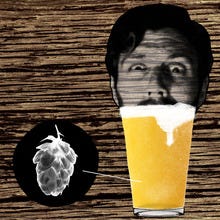By Brett Garling


By Brett Garling
Any beer drinker worth their malt is familiar with the American India Pale Ale. The brew is based on its British ancestor, which was extra hopped to stay drinkable after the long voyage to India. The American IPA, however, is extra, extra, (extra!) hopped. Hops add bitterness, allow for increased ABV (alcohol by volume), and give distinct aroma to beer. The bitterness is critical because it counteracts the sweetness of the malt. This flavor ying-yang forms the balance on which most beers teeter.
West Coasters have shifted this delicate balance toward the bitter, though. We’ve become IPA-crazed pagans. Don’t get me wrong — I love a good IPA. But some of these concoctions descend into a realm of masochistic palate whipping. Our lapping tongues and leathery livers are fast at work on some of the hoppiest beers on the planet.
Let’s take a moment here during SF Beer Week and review the IPA‘s cultural and chemical contours — and its growing bitterness — via a virtual beer flight.


Lagunitas IPA
Lagunitas Brewing
Petaluma, CA
(45.6 IBU • 5.7% ABV)
A California classic. If you live in San Francisco and drink beer, you’ve definitely splashed this delight down your gullet. Crisp and fresh, Lagunitas IPA is balanced and not overly bitter. The golden brew rings in at 45.6 International Bitter Units (IBU), which is moderate for the American IPAs (the ranking goes from 40 to over 100 IBU). Lagunitas also purports to use 43 different kinds of hops to give a complex, layered experience to its flagship IPA.
Magnum Single
Hop IPA
Hermitage Brewing Company
San Jose, CA
(70 IBU • 7% ABV)
A piney offering from a bold brewing company in the South Bay. Why bold? You see, different hops are typically blended in a beer to offer a complex and rounded flavor profile. I would, for instance, add salt, pepper, and maybe some cayenne pepper to fully season my soup. However, a sinister beast is now ravaging the frothing hop-heads of the West Coast: single hop beers, where one sole varietal is selected and unleashed into the brew. (The soup calls for salt. And then some more salt.) These monoliths of flavor take you far in one direction. Are single hopped beers enjoyable? The response from many marred mouths is muffled. Proceed at your own risk.
Knuckle Sandwich Double IPA
Bootlegger’s Brewery
Fullerton, CA
(87.8 IBU • 10% ABV)
An aggressive American Double IPA from Orange County. This brew highlights an interesting trend in hopped beers: wanting to kill you. Fleeing abuse from the Abrasive Double IPA from Surly Brewing Company? Duck! “Citrus notes exploding from the glass,” screeches Boneyard Beer’s website. Decapitation is very in, so make sure to try Drake’s Denogginizer. And, also, 10 Barrel Brewing’s Apocalypse IPA is a cult classic. Best yet, saddle up to Ninkasi’s Total Domination to get the shit kicked out of you. Hell, why not just end it all with Death By Hops from Olde Hickory Brewing, perhaps the first brewer to market itself on the promise of poisoning you to death.


Hop Henge Experimental IPA
Deschutes Brewery
Bend, OR
(99 IBU • 9.3% ABV)
A tasty terrorist attack of the Centennial and Cascade hops variety, and one unnamed ingredient. Yes, in pursuit of dynamic beers, brewers are delving into the murky world of experimental hops. These mysterious hybrids are given cryptic numbers — for example, did you get a grapefruit aroma from experimental hop #5? University of California Davis’ agriculture programs are at the forefront of this bitter biology, as are the hop growers of Washington State in the Yakima region. As hops deliver not only bitterness but also aroma, these innovators are pushing the flavor scope out of the traditional areas of “pine” and into the land of “melon” and “citrus.” Sniff at your own risk.
Pliny the Elder
Russian River Brewing
Santa Rosa, CA
(100 IBU • 8.0% ABV)
An extremely hoppy and heavily worshipped American IPA. In fact, this beer is what’s considered a double American IPA because of the amount of hops used and the high alcohol content. Typically, an American IPA is considered “double,” “triple,” or “imperial” as it rises above 7% ABV and beyond. At 100 IBU, Pliny the Elder nearly maxes out the scale and takes the bitterness blast to new heights. Trying to find a sweet malty note in this beer is like searching for a sanely priced apartment in San Francisco.
Ruination IPA
Stone Brewing
Escondido, CA
(100+ IBU • 8.2% ABV)
A “massive hop monster” from goblin-themed Stone Brewing, the largest brewer in Southern California. As a California beer drinker, I sometimes feel trapped in a dragon dungeon dedicated to palate oblivion. Brewers no longer believe it’s enough to include hops in just the boil. These leafy lads are now added to the primary fermentation, maturation tank, and to casked beer in a process known as “dry hopping.” And yet this process still doesn’t quite scratch the itch: meet the hopback, a filter crammed with hops through which the already hoppy-as-hell beer passes before being released into your pint glass. [WARNING: you will have to hire a private detective to find your tongue after this experience.]


Pure Hoppiness Double IPA
Alpine Beer Company
Alpine, CA
(Classified IBU • 8% ABV)
A secretive brew from outside of San Diego, the epicenter of the hop craze. Alpine Beer Company typifies the hoppiness competition between brewers, which has turned into an arms race when it comes to usage of the word “hop.” (Think “innovation” in Silicon Valley.) The company boasts, “A West Coast Double IPA so mega-hopped it will take you to hop heaven. We’ve used hops in the boil, more hops in the giant hopback, and added to that an incredible amount of dry-hopping for that cutting-edge ‘hop bite.’” If it’s going to kill us, at least we’re going to hop heaven. (Is it possible to get a Budweiser there?)

To you bitter souls, sip on!








